
| Galleries — Index |
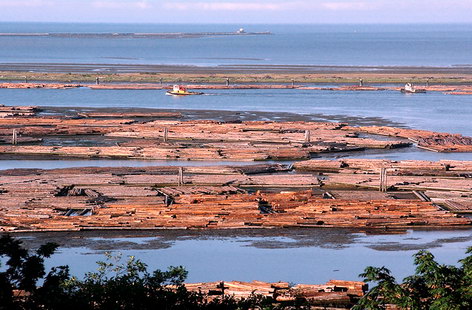 |
Endless
Raw Evidence
Left: Log booms on the mouth of the |
 |
 |
|
|
These images of log booms in BC expose the lies of the |
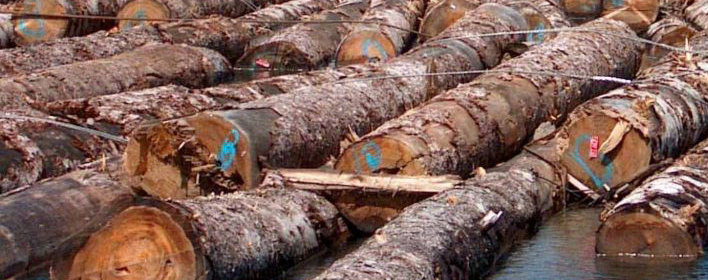 |
|
|
|
Raw Evidence of Deforestation: |
 |
 |
 |
 |
 |
 |
 |
 |
 |
 |
 |
 |
 |
 |
 |
|
|
|
These images of log barges in BC expose the lies of the |
 |

Right: Haida Brave with a full load of raw logs. None of the profits have gone to the indigenous peoples who rightfully own the forest lands which have been stolen from them and extensively pillaged. The homeland of the Haida People, the island archipelago Haida Gwaii, has been especially targeted by the forest industry. In the process, the giant Sitka spruce trees native to Haida Gwaii have virtually vanished due to their exploitation as high quality wood for the airplane industry in Seattle during both World Wars. |
Left: Haida Brave in Vancouver, 2010. Haida Brave facilitated the profiteering by forest industry corporations such as MacMillan Bloedel. BLOCKADE ENDS ON MACMILLAN BLOEDEL BARGE THE HAIDA BRAVE Protest ends after 38-hour occupation of world's largest log barge Howe Sound British Columbia August 9th, 1996 Greenpeace activists occupying one of the world's largest log barges, the Haida Brave, left the site of the two-day long blockade. Under RCMP supervision, the six activists, who had attached themselves to cranes and the log deck onboard the barge, disembarked the Haida Brave at 8:00 p.m. Pacific time. Said Karen Mahon, one of the people occupying the Haida Brave's crane, "'We successfully blockaded the Haida Brave for 38 hours, stopping it from dumping its load of clearcut rainforest logs. This is only the beginning. Greenpeace is determined to continue to work to protect the temperate rainforests and expose those responsible for its destruction." Satellite mapping has shown that over 50 per cent of the productive rainforests on the BC coast have already been logged. Company plans reveal that half of the remaining intact valleys will be logged or roaded in the coming five years. The Haida Brave and the Haida Monarch travel the BC coast two to three times per week, and on each trip carry the equivalent of 400 loaded logging trucks. Approximately 25-million cubic meters of British Columbia's 73-million meters Allowable Annual Cut is oldgrowth temperate rainforest. 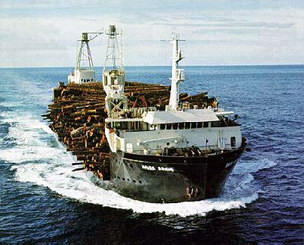 |
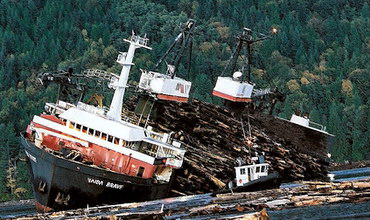
Right: Photo of Haida Warriors in a traditional canoe carved from a single cedar tree, flying the Haida Nation flag, on route to protest against the Haida Brave on 1 August 1996. They stopped the world's biggest log barge with its pillaged cargo of old growth cedars from proceeding through Masset Inlet on Haida Gwaii. |
Left: Haida Brave self dumping log barge. Haida artist Michael Nicoll Yahgulanaas took part in the blockade of the Haida Brave self dumper. "How Many Canoes Are On That Black Ship?" he wrote, "The bloated bow of the ship is a great monstrous maw and as if swallowed into the monster's belly a black gut wall rises behind the canoe. A canoe filled with Haida souls and a single red flag flies on a choppy swell as hundreds of ancient cedar logs hang overhead" Black Ship (Spruceroots). 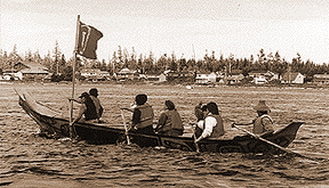 |
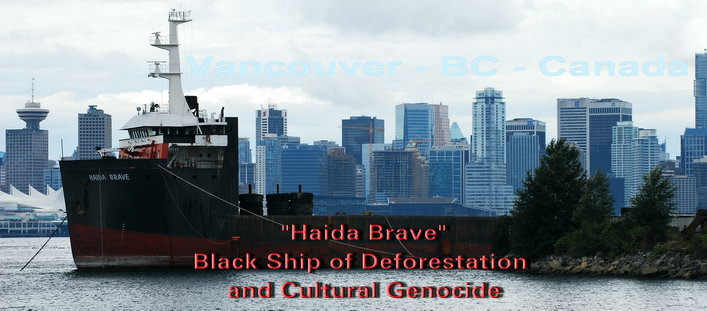 |
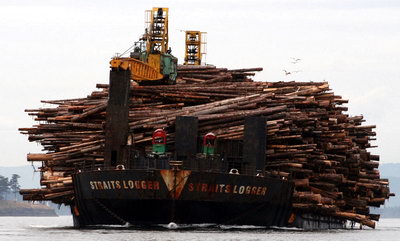 |
Above: Spear
Flower. The rapacious deforestation of BC for Asian markets is deplorable.
There needs to be an international convention to protect local communities
from being stripped of their resources by transnational corporations.
In 2005 angry BC citizens, fed up with the endless export of raw
logs, protested against the Spear Flower, the evil Black Ship, while
it was being loaded in Port Alberni on Vancouver Island. |

Straits Logger

Straits Logger and Haida Brave loaded on the transport barge Development Way,
Vancouver, British Columbia, 12 April 2012.

mmm
|
|
|
Raw Evidence of Deforestation: |
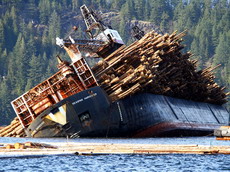 |
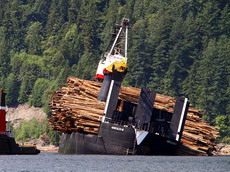 |
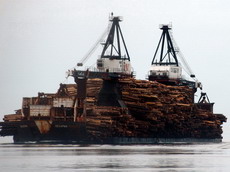 |
 |
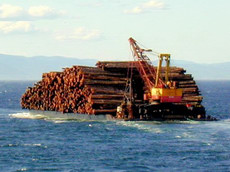 |
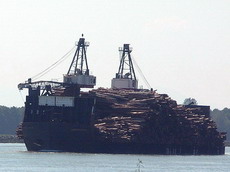 |
 |
 |
 |
 |
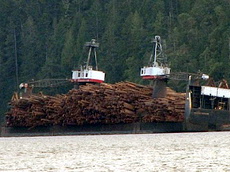 |
 |
 |
 |
 |
 |
 |
 |
 |
| |